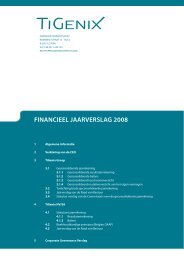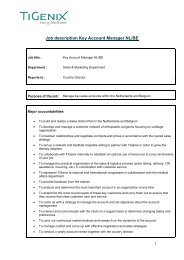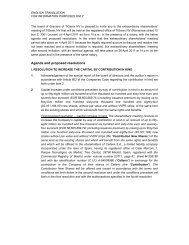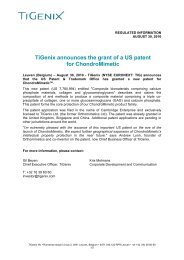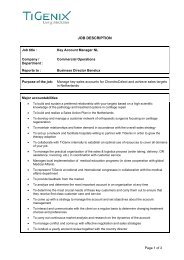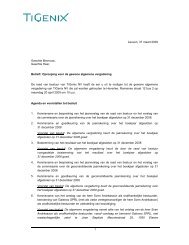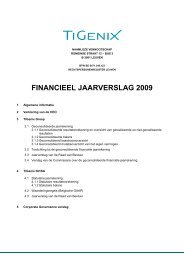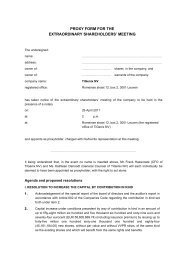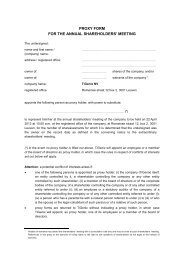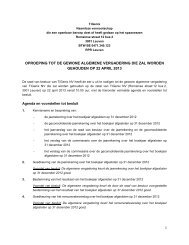ANNUAL REPORT 2012 - TiGenix
ANNUAL REPORT 2012 - TiGenix
ANNUAL REPORT 2012 - TiGenix
You also want an ePaper? Increase the reach of your titles
YUMPU automatically turns print PDFs into web optimized ePapers that Google loves.
of interest on the remaining balance of the<br />
liability. Finance charges are expensed.<br />
Rentals payable under operating leases are<br />
charged to income on a straight-line basis<br />
over the term of the relevant lease. Benefits<br />
received and receivable as an incentive to<br />
enter into an operating lease are also spread<br />
on a straight-line basis over the lease term.<br />
11.5.2.11. Impairment of tangible<br />
and intangible assets<br />
At each balance sheet date and at each<br />
interim reporting date, the Group reviews<br />
the carrying amount of its tangible and<br />
intangible assets to determine whether<br />
there is any indication that those assets have<br />
suffered an impairment loss. If any such<br />
indication exists, the recoverable amount of<br />
the asset is estimated in order to determine<br />
the extent of the impairment loss (if any).<br />
Where the asset does not generate cash<br />
flows that are independent from other assets,<br />
the Group estimates the recoverable amount<br />
of the cash-generating unit to which the<br />
asset belongs. An intangible asset with an<br />
indefinite useful life is tested for impairment<br />
annually and at each interim reporting date,<br />
and whenever there is an indication that the<br />
asset might be impaired. The recoverable<br />
amount is the higher of fair value less costs<br />
to sell and value in use. The estimated future<br />
cash flows are discounted to their present<br />
value using a pre-tax discount rate that<br />
reflects current market assessments of the<br />
time value of money and the risks specific to<br />
the asset.<br />
If the recoverable amount of an asset or cash<br />
generating unit is estimated to be less than<br />
the carrying amount, the carrying amount<br />
of the asset is reduced to its recoverable<br />
amount. An impairment loss is immediately<br />
recognized as an expense, unless the<br />
relevant asset is carried at re-valued amount,<br />
in which case the impairment is treated<br />
as a revaluation decrease. Where an<br />
impairment loss subsequently reverses, the<br />
carrying amount of the asset is increased<br />
to the revised estimate of its recoverable<br />
amount, but so that the increased carrying<br />
amount does not exceed the carrying<br />
amount that would have been determined<br />
had no impairment loss been recognized<br />
for the asset in prior years. A reversal of an<br />
impairment loss is recognized as income,<br />
unless the relevant asset was carried at revaluated<br />
amount, in which case the reversal<br />
of the impairment is treated as a revaluation<br />
increase<br />
11.5.2.12. Inventories<br />
Raw materials, consumables and goods<br />
purchased for resale are valued at the lower<br />
of their cost determined according to the<br />
FIFO-method (first in first out) or their net<br />
realisable value.<br />
The costs of finished goods comprises all<br />
costs of purchase , costs of conversion<br />
and other costs incurred in bringing the<br />
inventories to the present location and<br />
condition.<br />
The Group does not account for work in<br />
progress, as the production process is short<br />
and finished goods are shipped to customers<br />
immediately thereafter, resulting in no such<br />
items on the balance sheet at year-end for<br />
any of the periods reported.<br />
117



